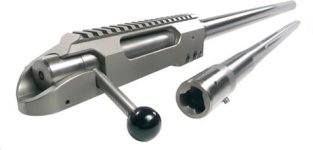jackie schmidt
New member
Leeroy
Another note, the basic design of the Remington 700 familly of actions, with the "THREE RINGS OF STEEL" concept, is recognized as one of the safest bolt actions ever designed.
I have seen these withsatnd a complete case head failure, and the case still contained inside the chamber and barrel assy, with no damage to the shooter.
The only drawback to the Remington design is many think the extractor is on the weak side. Sure, it might be when compared to a Sako style, but that is a compromise that had to be made in order to insure that the "three rings of steel" would truly be a viable concept.
I would be interested to know that since the originol 721-722, the forerunners of the Remington 700 design, has there EVER been an instance of the bolt luggs actully failing on a Remington bolt??. I have never heard of one.
Back when PO Ackely did his "load to destruction" test on all of the old Military Rifles, did one ever lost the bolt luggs???
As you stated before, follow good, sound machine shop practice, go with a tried and true design, and you cannot go wrong.
Insidentally, the only reason we use a cone bolt in a single shot Benchrest Rifle is so the rounds will feed easilly off of a ramp that is darned near in line with the chamber. It is not that practicle for other applications, and certainly not for a Rifle that must feed from amagazine.........jackie
Another note, the basic design of the Remington 700 familly of actions, with the "THREE RINGS OF STEEL" concept, is recognized as one of the safest bolt actions ever designed.
I have seen these withsatnd a complete case head failure, and the case still contained inside the chamber and barrel assy, with no damage to the shooter.
The only drawback to the Remington design is many think the extractor is on the weak side. Sure, it might be when compared to a Sako style, but that is a compromise that had to be made in order to insure that the "three rings of steel" would truly be a viable concept.
I would be interested to know that since the originol 721-722, the forerunners of the Remington 700 design, has there EVER been an instance of the bolt luggs actully failing on a Remington bolt??. I have never heard of one.
Back when PO Ackely did his "load to destruction" test on all of the old Military Rifles, did one ever lost the bolt luggs???
As you stated before, follow good, sound machine shop practice, go with a tried and true design, and you cannot go wrong.
Insidentally, the only reason we use a cone bolt in a single shot Benchrest Rifle is so the rounds will feed easilly off of a ramp that is darned near in line with the chamber. It is not that practicle for other applications, and certainly not for a Rifle that must feed from amagazine.........jackie


